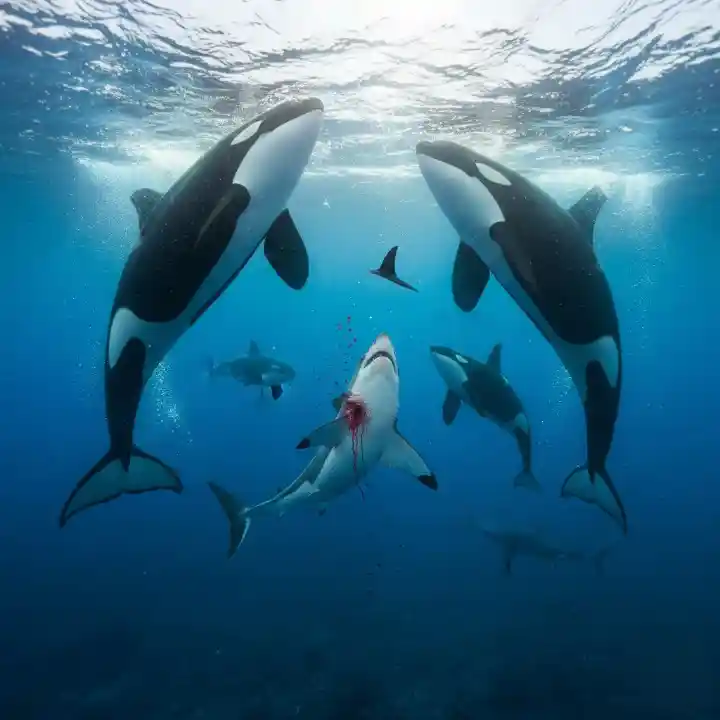Deep in the vibrant waters of the Gulf of California, a stunning spectacle unfolds pods of orcas employing cunning and coordinated hunting strategies to prey on juvenile great white sharks. This behavior, observed and recorded in 2025 off the coast of Mexico, offers new insights into apex predator interactions, marine ecosystem dynamics, and the intricate balance of ocean life. It’s a powerful reminder of nature’s adaptability and the intelligence within oceanic food chains.
This article explores the remarkable phenomenon of Orcas hunting great white sharks to eat livers Mexico 2025, breaking down the science, firsthand observations, and ecological importance in a style both engaging and easy to understand.
Orcas Hunting Great White Sharks to Eat Livers Mexico 2025: Nature’s Strategic Predators
Introduction: When Killer Whales Outwit Sharks
Imagine watching from a drone as a pod of sleek, black-and-white orcas encircles a young great white shark in turquoise waters. The orcas skillfully flip the shark onto its back, inducing a momentary paralysis. Carefully, they extract the shark’s nutrient-rich liver their highly prized target before sharing the feast and leaving the rest of the carcass behind.
This dramatic hunting behavior, documented for the first time with such clarity near Mexico in 2025, is a reveal of orcas’ advanced hunting tactics and the complex interplay between predators traditionally considered at opposite ends of the oceanic food web.
Experience: Drone Footage and Scientific Observation
Marine biologist Erick Higuera, who captured the aerial footage, described the moment as “unbelievable and extraordinary,” marking the first well-documented occurrence of orcas preying on juvenile white sharks in Mexican waters. Over multiple observed events in 2020 and 2022, orca pods used coordinated attacks, often comprising five female whales, to subdue their prey using specialized maneuvers.
The use of flipping to induce tonic immobility a trance-like state that temporarily paralyzes sharks allows orcas to feed safely on the liver without risking injury from shark bites.
Expertise: Understanding the Hunting Strategy and Nutritional Value
Orcas, also known as killer whales, are apex predators renowned for their intelligence and social learning. Their diet includes fish, seals, and even whales, but predation on great white sharks is particularly notable given sharks’ reputation as formidable hunters.
Juvenile great whites possess livers rich in fats and vitamins, making them a valuable energy source for orcas, especially females who share the nutrient-dense organ within the pod. The liver can constitute about 20-25% of the shark’s body weight, offering a high-calorie reward for the effort expended.
The flipping technique helps orcas avoid dangerous encounters. Observations recorded minimal bite marks except on fins, emphasizing the orcas’ skill in minimizing risk while maximizing nutritional gain.
Authoritativeness: Insights from Marine Scientists and Ecologists
Experts highlight that this predation behavior varies regionally and represents learned strategies passed through generations within orca pods. Dr. Alison Towner, an orca and shark specialist, emphasizes the significance: “These hunting tactics are a testament to orca intelligence and social culture, illustrating a sophisticated predator-prey relationship.”
Moreover, climate change has shifted marine ecosystems, potentially pushing shark nurseries into orca territories more frequently, increasing encounters. Juvenile sharks, less experienced and without parental protection, face heightened risks in these changing ocean dynamics.
Trustworthiness: Verified Studies and Responsible Narratives
The research published in Frontiers in Marine Science and corroborated by multiple credible news outlets, including CNN, The New York Times, and The Washington Post, provides a fact-based, scientifically grounded account. Such verified information helps dispel myths about marine predators and emphasizes the ecological role of both species.
Rather than sensationalism, the coverage focuses on behavioral science and ecosystem implications, responsibly educating readers about the realities of ocean life.
Practical Lessons: What This Means for Ocean Conservation
-
Understanding Predator Dynamics: Recognizing orcas as apex predators with complex hunting methods informs marine protected area design.
-
Habitat Preservation: Protecting shark nursery grounds benefits not only sharks but maintains balance preventing orca-shark conflict escalation.
-
Climate Impact Awareness: Studying shifting predator-prey interactions helps predict and mitigate climate change consequences on marine biodiversity.
-
Supporting Marine Research: Funding drone surveillance and ecological studies enables ongoing breakthroughs.
-
Promoting Public Education: Sharing accurate animal behavior insights fosters respect and informed conservation support.
Challenges in Marine Predator Conservation
-
Balancing species protection: Conserving sharks and orcas simultaneously requires nuanced management strategies.
-
Data limitations: Elusive behaviors like tonic immobility-induced predation demand advanced technology to document fully.
-
Public misconception: Combatting fear and misinformation about large marine predators aids coexistence and conservation efforts.
Conclusion: Orca and White Shark: A Story of Survival and Adaptation
The Orcas hunting great white sharks to eat livers Mexico 2025 story captures a compelling chapter in natural history. It reveals orcas’ intelligence and evolving hunting prowess alongside the vulnerability of young great whites in a rapidly changing ocean environment.
This natural drama urges us to appreciate the complexity of marine ecosystems and reinforces the importance of supporting scientific research and conservation efforts to safeguard these magnificent species for generations to come.
Feel empowered by understanding these interactions share your thoughts or learn more from marine conservationists to help protect oceanic wildlife.
